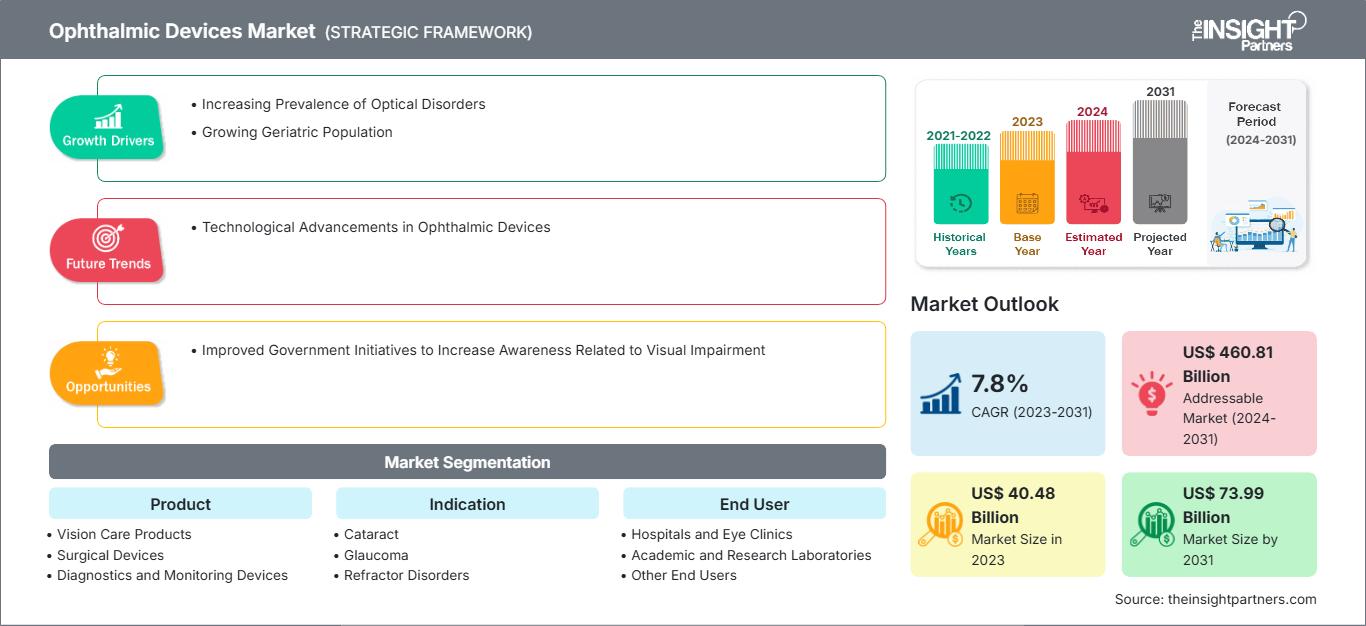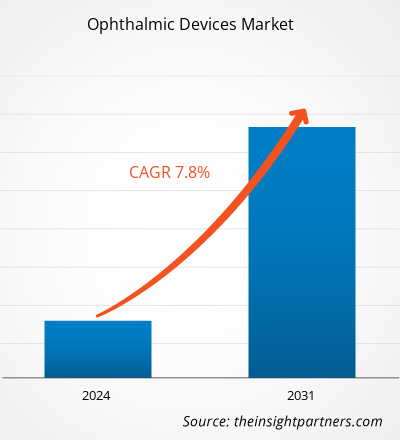预计到2031年,眼科器械市场规模将从2023年的404.8亿美元增至739.9亿美元;预计2023年至2031年期间的复合年增长率将达到7.8%。
眼科器械是用于视力矫正、诊断和手术的医疗设备。近年来,由于青光眼、白内障和其他视力相关疾病的发病率激增,人们对眼科器械的认知度和普及度也大幅提升。老年人口的增加和眼科疾病患病率的飙升预计将在未来几年推动眼科器械市场的发展。眼科设备市场趋势包括眼科设备的技术进步,这将有利于未来市场的增长。
增长动力:
美国、英国、加拿大和日本等发达国家以及中国、印度和韩国等发展中国家的老年人口激增,这是由于医疗设施的现代化和医疗服务的改善所致,从而提高了这些国家的预期寿命。人口老龄化对世界社会和经济产生了重大影响。世界各国都在采用新技术来安全有效地治疗老年人口。因此,生活质量的提高导致死亡率下降,进而导致老年人口激增。根据世界卫生组织 2022 年的数据,到 2030 年,每 6 人中就有 1 人年龄在 60 岁以上;预计 60 岁及以上人口将从 2021 年的 9 亿增长到 2050 年的 20 亿。到 2050 年,这个年龄段的全球人口比例将从 2015 年的 12% 翻一番,达到 22%。根据联合国经济和社会事务部 2019 年的报告,全球 65 岁及以上人口约有 7.03 亿,预计到 2050 年将翻一番,达到 15 亿。
青光眼是 60 岁及以上人群失明的主要原因,60 岁以后患青光眼的可能性要高出六倍。根据 2022 年国家青光眼研究情况说明书,超过 300 万美国人患有青光眼,其中 270 万患者年龄在 40 岁及以上。其他失明原因包括糖尿病视网膜病变、年龄相关性黄斑变性和视网膜脱离。美国疾病控制与预防中心 (CDC) 指出,2021 年美国 25 岁以下人群糖尿病视网膜病变的患病率最低(13.0%),65-79 岁人群患病率最高(28.4%)。年龄相关性眼病也被认为是美国失明和低视力的主要原因。因此,老龄化人口更容易患上各种需要早期诊断和治疗的眼部疾病,这反过来又推动了对眼科设备的需求,促进了眼科设备市场的增长。
自定义此报告以满足您的要求
您将免费获得任何报告的定制,包括本报告的部分内容,或国家级分析、Excel 数据包,以及为初创企业和大学提供超值优惠和折扣
眼科设备市场: 战略洞察

-
获取本报告的主要市场趋势。这个免费样本将包括数据分析,从市场趋势到估计和预测。
报告细分和范围:
眼科设备市场分析考虑了以下几个部分:产品、适应症、最终用户和地域。根据产品,市场细分为视力保健产品、手术设备以及诊断和监测设备。在适应症方面,市场分为白内障、青光眼、屈光不正和其他适应症。根据最终用户,市场分为医院和眼科诊所、学术和研究实验室以及其他最终用户。眼科设备市场报告的范围涵盖北美(美国、加拿大和墨西哥)、欧洲(法国、德国、英国、西班牙、意大利和欧洲其他地区)、亚太地区(中国、日本、印度、韩国、澳大利亚和亚太其他地区)、中东和非洲(沙特阿拉伯、南非、阿联酋和中东和非洲其他地区)以及南非和中美洲(巴西、阿根廷以及南美洲和中美洲其他地区)。
分段分析:
按产品划分,眼科设备市场分为视力保健产品、手术设备以及诊断和监测设备。视力保健产品细分市场在 2023 年占据了相当大的市场份额。预计在 2023 年至 2031 年期间,该细分市场将录得最高的复合年增长率。
根据适应症,市场分为白内障、青光眼、屈光不正和其他适应症。青光眼细分市场在 2023 年占据了相当大的眼科设备市场份额,预计在 2023 年至 2031 年期间,该细分市场将录得最高的复合年增长率。
根据最终用户,市场细分为医院和眼科诊所、学术和研究实验室以及其他最终用户。 2023 年,医院和眼科诊所部门占据了眼科设备市场相当大的份额,预计在 2023 年至 2031 年期间将实现最高的复合年增长率。
区域分析:
就地域而言,眼科设备市场分为北美、欧洲、亚太地区、南美和中美以及中东和非洲。2023 年,北美占据了相当大的市场份额。2023 年,美国主导了该地区的眼科设备市场。北美市场的增长归因于白内障、青光眼、糖尿病视网膜病变、年龄相关性黄斑变性 (AMD) 和屈光疾病等眼部疾病负担的增加;老年人口的增加;技术先进的眼科设备的接受度激增;以及该地区重要市场参与者的存在。随着65岁及以上人口的激增,美国老年性黄斑变性(AMD)等与年龄相关的疾病病例也呈上升趋势。根据美国国立卫生研究院的报告,2000年至2010年,AMD患者人数增长了18%,从2000年的175万人增至2010年的207万人。预计到2050年,AMD患者人数将从207万人增至544万人。根据2023年发表的《2021年美国糖尿病视网膜病变患病率》研究报告,2021年美国约有960万人患有糖尿病视网膜病变,约有180万人患有威胁视力的糖尿病视网膜病变。这导致对诊断眼科工具的需求增加,从而推动该地区眼科设备市场的增长。
眼科设备市场
The Insight Partners 的分析师已详尽阐述了预测期内影响眼科设备市场的区域趋势和因素。本节还探讨了北美、欧洲、亚太地区、中东和非洲以及南美和中美洲的眼科设备市场细分和地域分布。
眼科设备市场报告范围
| 报告属性 | 细节 |
|---|---|
| 市场规模 2023 | US$ 40.48 Billion |
| 市场规模 2031 | US$ 73.99 Billion |
| 全球复合年增长率 (2023 - 2031) | 7.8% |
| 历史数据 | 2021-2022 |
| 预测期 | 2024-2031 |
| 涵盖的领域 |
By 产品
|
| 覆盖地区和国家 |
北美
|
| 市场领导者和主要公司简介 |
|
眼科设备市场参与者密度:了解其对业务动态的影响
眼科设备市场正在快速增长,这得益于终端用户需求的不断增长,而这些需求的驱动因素包括消费者偏好的演变、技术进步以及对产品优势的认知度的提升。随着需求的增长,企业正在扩展产品线,不断创新以满足消费者需求,并抓住新兴趋势,从而进一步推动市场增长。

- 获取 眼科设备市场 主要参与者概述
行业发展与未来机遇:
眼科设备市场报告涵盖公司定位和集中度,以评估市场竞争对手的表现。根据公司新闻稿,以下列出了市场主要参与者采取的一些举措:
- 2021年7月,Topcon Corporation收购了总部位于意大利佛罗伦萨郊区的眼科设备制造商VISIA Imaging Srl。通过此次收购,Topcon旨在进一步增强其定位良好的眼底成像设备产品组合——包括眼底照相机和光学相干断层扫描(OCT)。此次收购增强了Topcon在前段设备和软件方面的开发和生产能力。此次收购也旨在巩固Topcon作为眼科诊断工具顶级生产商的地位。
- 2021年3月,Iridex Corporation与Topcon Corporation达成战略合作。 Iridex Corporation 是一家知名的创新型眼科激光医疗产品供应商,其产品用于治疗青光眼和视网膜疾病。Iridex 收购了 Topcon 的 PASCAL 产品线,将其自身的微脉冲技术与 Topcon 的 PASCAL 激光平台相结合,以扩大其在视网膜扫描激光产品市场的份额。
竞争格局和主要公司:
眼科设备市场预测可以帮助利益相关者规划增长战略。爱尔康 (Alcon)、Topcon、博士伦 (Bausch + Lomb)、卡尔蔡司医疗 (Carl Zeiss Meditec)、Haag Streit Holding、依视路 (Essilor)、强生视力 (Johnson & Johnson Vision)、尼德克 (Nidek Co. Ltd)、豪雅 (Hoya Corporation) 和库博光学 (CooperVision) 是市场上的知名企业。这些公司专注于推出新的高科技产品、改进现有产品并拓展地域范围,以满足全球日益增长的消费需求。
- 历史分析(2 年)、基准年、预测(7 年)及复合年增长率
- PEST和SWOT分析
- 市场规模、价值/数量 - 全球、区域、国家
- 行业和竞争格局
- Excel 数据集
近期报告
客户评价
购买理由
- 明智的决策
- 了解市场动态
- 竞争分析
- 客户洞察
- 市场预测
- 风险规避
- 战略规划
- 投资论证
- 识别新兴市场
- 优化营销策略
- 提升运营效率
- 顺应监管趋势






















 获取免费样品 - 眼科设备市场
获取免费样品 - 眼科设备市场